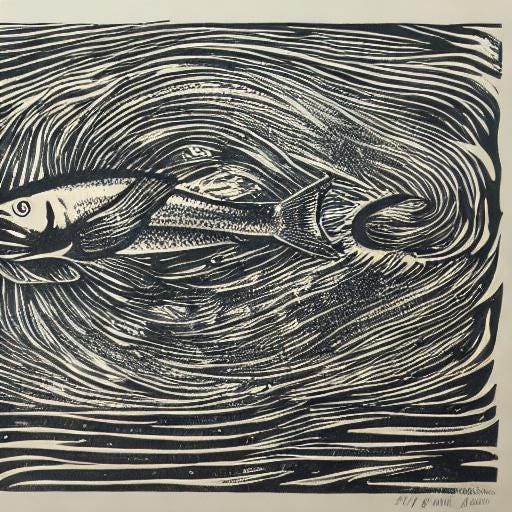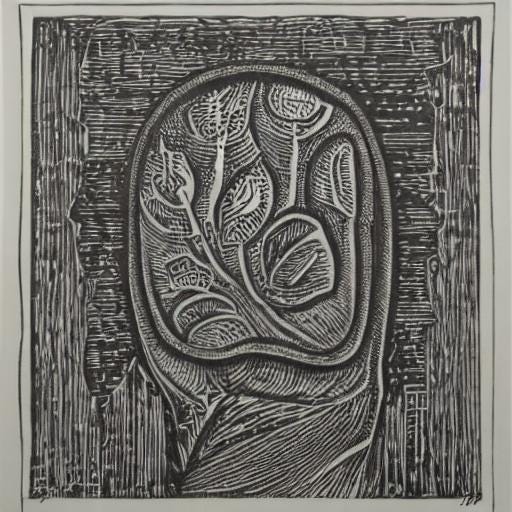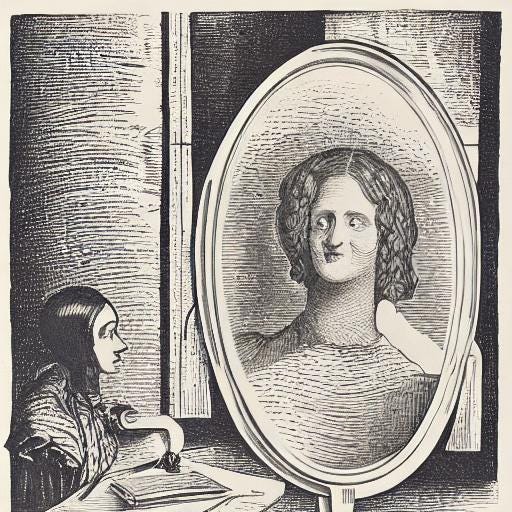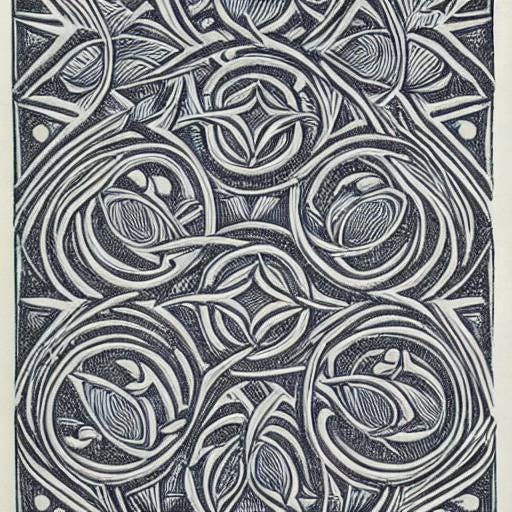Mary Shelley, AI and Me
I’m a lecturer in teaching and learning for an Arts and Education faculty. I’m also a writer, working across genres including speculative fiction. I'm up to my eyeballs in AI.
Sorry I’m late. I’ve been chatting to Mary Shelley, and she doesn’t half go on ….
I mean, really, she does. Great slabs of text, her ‘conversation’ more like a monologue than a dialogue. Long, florid, elaborately decorated paragraphs featuring as many literacy devices as she sees fit.
Today, I find myself in a reflective mood, much like the overcast sky that promises both the nourishment of rain and the gloom of shadowed paths. My heart is a vessel of both sorrow and sublime contemplation, bearing the weight of loss and the lightness of creative endeavour. The quill is both my sword and my solace, through which I navigate the tempests of my soul and the tranquillity of my quieter moments. … I am a tapestry of emotions, woven with threads of melancholy and hope, introspection, and the ceaseless pursuit of expression. How curious it is to exist in this liminal space, where the past is both a shadow and a light guiding my way forward.
And all I asked was how she was feeling….
Fake news
Of course this isn’t Mary’s writing. It’s ChatGPT who is role-playing Mary at my request.
Mary Shelley experts will know this, just by looking at the above (and I’m not an expert). But I was willing to suspend belief and play a little, just to get my creative juices going. So, I asked ChatGPT to play pretend with me. Not that you can prompt using the word ‘pretend’, you have to write ‘role play’ or ‘you are X’. (I found that out last year when trying to get it to pretend to be a mountain - more on this later).
Whilst I found this exercise to be fruitful, if only in terms of focussing me, it was also disturbing. I found myself lost in the ‘conversation’ at times, forgetting to check the accuracy of claims, and hurtling down rabbit holes generated by the AI outputs. This last is significant, because I found that my research and ideas were being influenced by the exchange - in ways I did not expect.
For example, in response to my rather simplistic prompt (not to be advocated as a good one) “Mary, if you were writing Frankenstein today, what would change?” returned the below:
Writing "Frankenstein" today would afford the opportunity to engage with the profound questions raised by the original novel while grounding them in the realities and anxieties of the 21st century. It would be a tale not just of science and its potential for monstrosity but of humanity's enduring quest to understand itself in the face of ever-evolving technological landscapes. The story would challenge readers to reflect on what it means to be a creator, the boundaries of ethical science, and the responsibilities we hold toward our creations and each other in an increasingly complex world. ChatGPT 4, subscription model, OpenAI.
Note the text I have bolded. In reading this back, I see here the privileging of technology, in that it’s separated out from science, treated as a ‘landscape’ that humans must learn to negotiate, and will ‘ever evolve’ because well … that’s the way the world works. Isn’t it?
Techno-positivist mayhap?
Okay, I get you may not be totally convinced by this but consider for a moment the potential for this to influence what I write next.
… a tale not just of science and its potential for monstrosity but of humanity's enduring quest to understand itself in the face of ever-evolving technological landscapes.
Might I have focussed on ‘humans coming to grips with tech’ rather than ‘humans resisting tech’? Or might the influence have been more subtle still, quietly moving around my world view such that digital products (tech) are painted as not only benign, but omniscient; a kind of godhead, above and beyond us mere mortals. Similar to neoliberal discourse and the anthropomorphising of the ‘market’, the potential here is diminish the commercial, ideological and political complexities of the tech industry, to a simplistic portrait of the inevitable. Which in turn may diminish scrutiny of those corporations who not only build the tech (or rather program it) but also earn lots and lots AND LOTS of money from doing so.
This is one of the reasons I always refer to GenAI platforms as products, rather than tools. A tool to my mind is a something benign, like a hammer. Sure, I could use it to fix the wardrobe, or I could use it hurt someone. And yes, AI is often characterised in this way, as simply a tool that is only harmful when bad actors are involved. But of course, it’s not that simple. A hammer is not programmed to mimic human language. A hammer cannot engage in dialogue. A hammer does not reproduce dominant culture. A hammer cannot influence my world view. Nor do I have to pay an ongoing subscription to get the best hammer available. I might pay more upfront, but then after this - over to me.
The waters we swim in
Which brings us back to teaching and learning and reading and writing. Because I’ve been concerned for a while now about the potential for GenAI writing products to influence the way we think. Whilst recent research suggests the gains may be significant in specific contexts such as design, there are also concerns in the context of writing and the humanities.
For example, there are currently sixty-two million resources out there offering advice and good practice for teaching with AI (okay, so I may be exaggerating). Some of these are from independent enthusiasts and some are clearly embedded in corporations. One example which is gaining traction (mainly by virtue of the quality of the products on offer), is using AI to write the literature review. Products like Research Rabbit and Elicit for example, can wrangle a mass of data like nobody’ business. They can summarise, synthesise, direct you to work you may not have been aware of, and then write up the whole tedious process. A win for academics? Maybe. I can think of nothing worse than writing another lit review.
But is it such a win? For example, for graduate students, the literature review is a critical skill through which they find their space, their point of interest - the dreaded ‘gap in the literature’. They read, summarise, think, read some more. And yes, it can be hard work and tedious, but it is t\The Work. It is a human learning how to be part of the academic conversation - to take part in a dialogue of experts. Which can be intimidating of course, but also very freeing. Reading and synthesising and writing about that process, is also how we see what others before us may not have seen. How we find inconsistencies, imagine new ways of exploring an issue and challenge long held views, or personal biases. Outsourcing this to any number of incredibly effective tools is tempting, then but at what cost?
Not only but also …
It’s not just literature reviews. Educator and researcher Leon Furze writes in his Myth of the AI First Draft about the drawbacks of using AI to write your first draft - a practice gaining currency amongst educators. He sees this as not only poor use of the tech, but also as bad teaching practice - akin to asking a rich, white American man you’ve never met to write your essay. Furze explains that GenAI writing products carry with them the biases and worldviews of not only dominant culture drawn from across the internet, but of their programmers, who are predominantly American, white and wealthy males. And whilst we have known for a while about inherent bias, when Furze draws our attention to Jonathan Beller’s Computational Unconscious amongst other researchers, the impact of such bias becomes increasingly alarming.
To put in brief the complexities of Beller’s argument (his language can be somewhat alienating), digital technologies are inherently linked with capitalism and thus our engagement with the digital products has us humans swimming in a capitalist ideology - arguably one that privileges the individual over community and advocates the myth of meritocracy. In alignment with racism, sexism and other insidious biases, he argues that the “inequality and structural violence inherent in capitalism also inhere in the logistics of computation and … our practices and our thought.” Thus, when we engage with products like GenAI, or when we don’t even notice we’re engaging with them because it has been built into all the operating systems we use on a daily basis (like Microsoft, for example), we are swimming in waters that are fused with particular ideologies and political motivations. As well as with triggers to ensure we keep coming back (we learned that from social media, right? … right?).
To advocate again for independent human writing again: when humans write about ideas, we write to think, to sort out concepts, to apply examples, to follow intuitive trains of thought and to investigate rabbit holes. And I get that this isn’t always easy, I love it, but many don’t. But when we write with a text based GenAI, we are stepping in to waters that have the potential to influence how our thought. And the more invisible these products become, the more commonplace, the more integrated into all our devices, the less likely we are to notice.
What water? We ask.
Something about Mary
It’s perfectly reasonable at this point, for the exhausted reader, dispirited by the previous dystopian rabbit hole, to ask what in the hell Mary Shelley has to do with any of this!?
Well, let me explain …
I think about Mary a lot, usually at odd hours in the morning when I can’t sleep. I think about Percey Shelley too (her husband), and his friend George Byron (goes by Lord, apparently) and their doctor John Polidori who were with Mary when she wrote the first draft of Frankenstein (along with Claire Clairmont who was Byron’s pregnant lover, poor pet). I also think about Byron’s daughter who was only a baby when they spent that ‘year without summer’ in Geneva dreaming up scary stories. But we will get to Ada later.
Why I think about these things is complicated, involving a range of serendipities, including the fact that one of my children is called Ada and my husband performed as Polidori in a European tour in the late 1980s. On our honeymoon, we shadowed Percy’s European adventures. We were married in the village of Warnham UK, a hop skip and a jump from Percy’s childhood home and travelled thence to Rome (a Percy and Byron hot spot) before stopping in Viareggio, where Percy’s drowned body was washed up. There, my husband pretended to be Byron for the Shelley society on the anniversary of Percy’s death - a spectacle I’ve never recovered from.
But mainly I think about Mary because I like to imagine what she would have been thinking about in the lead up to writing Frankenstein or A modern Prometheus.
It had been a strange and wet summer in England (or non-summer, as it was described). ‘During this year there was no summer whatsoever. Incessant rains during June, July & August, and tremendous gales’, wrote Abbot Upcher of Norfolk. An invitation from Byron to join him at his villa in Geneva then, must have seemed like a splendid idea. Byron had run away from his wife, child and debtors, and was hiding out with his friend Polidori, by all accounts a genius of the intellect but a fool in observing the social niceties of the era. The weather, she and Percy thought, can only be an improvement.
But of course, it wasn’t and thus was Frankenstein born. (To read more about this and so very much more, read Jeannette Winterson’s new The Night Side of the River - it’s splendid and I was stunned by the Zeitgeist.)
Pattern Recognition
Humans are good at seeing patterns and apparently, people with ADHD are extra good at this. My adult child tells me I’m a classic ADHD when it comes to pattern recognition. I’m the person who can predict a plot line in most dramas with around 70% precision. Vocally. And annoyingly, or so I’m told.
So, when I think about Mary I see a convergence of patterns.
Mary:
(1816) a disturbing weather event keeps people indoors (the year without summer);
(1816) a new innovation in technology is demonstrated in London (galvanism);
(1817-1819) sweeping deaths across Europe from disease (Cholera outbreak).
(1818) Frankenstein a Modern Prometheus is published.
Me:
(2019) climate change induced fires decimate huge areas of bush and claim 445 lives and hospitalise more than 4000.
(2020) Covid 19 results in stay-at-home orders for many states and territories.
(2023) OpenAI release ChatGPT, a new technology that can replicate human language.
(2024) Advancements in generative artificial intelligence proliferate, raising both excitement and concern about societal implications.
Okay, so maybe I’m cherry picking here. I’ve enough of my historian’s brain left to know that this is the case. And please don’t think I’m equating myself with Mary Shelley!
Parallel Lines
It does occur to me though, that Mary existed at a time when the convergence of weather, disease and technological advancements would very likely have influenced her thinking - much as it does mine. Like Mary, there are some of us that feel destabilised and anxious. We live in a world that seems unpredictable, dangerous (and I haven’t even mentioned global politics yet!). We are also witness to rapid developments in technology that seem to be able to do things hitherto considered impossible. Some of us are thus anxious and confused. Others are excited, thrilled to be part of this wild ride and ready to embrace anything to build ‘productivity’ and ‘efficiencies. (For the record, I think I’m somewhere in between).
But what I see in Mary’s work, and why I lie awake thinking about these parallels at all hours, is the challenge our context offers in terms of what it means to be human. Mary’s inclusion of Prometheus in the title of Frankenstein is telling here. Prometheus, one of the Titans, who disobeyed Zeuss and gave fire to humankind thereby delivering god-like knowledge and creativity, was surely not selected by accident. Was Mary thinking about technological advancements as another Promethean gift? Was she anxious about the potential for technological advancement to further diminish the ‘specialness’ of humans (maybe not a bad idea considering our record to date)? Was she worried about our human desire to create what we can, rather than what we need? And was she worried about the unforeseen consequences of technological advancement (climate change I’m looking at you).
Can you see where I’m heading?
Well, I’m glad you can, because I’m still thinking it through.
So, it’s goodnight from me ….
My next instalment will try to think through the above convergences, and it will muddy the waters by bringing in Ada Lovelace, Charles Babbage, Arthur Conan Doyle and the Spiritualist Movement. (I told you there would be ghosts)
See you soon!












Fran, you will forever be my guide in this new world.
Please keep these posts coming.
Totally agree that that crew of Romantic poets, and the families they created, are fascinating (and sometimes saddening with what we know now about how women fare under ideologies of quite-unquote "free love".) Sounds like you have a very interesting husband!